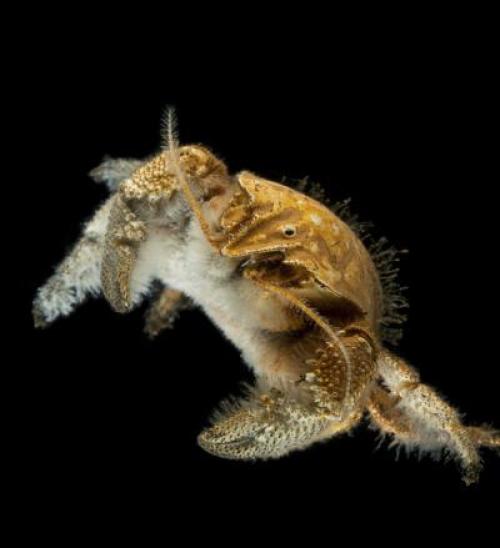We're open daily! View holiday hours
Science News
Hoff Crabs
June 28, 2013
by Molly Michelson

As a science writer, I get to write about very interesting subjects. But I never thought David Hasselhoff would become part of my oeuvre.
Hoff crabs are an undescribed species (or two) of the genus Kiwa that live on hydrothermal vents near Antarctica. Named after David Hasselhoff, Hoff crabs sport “hairy” (actually setae) chests—similar to that of the Baywatch, reality and singing star (and general trainwreck).
Hoff crabs live in one of the most extreme environments on the planet: over 2,000 meters under the sea, with no light and very little oxygen, where volcanic vents superheat the water to 380° Celsius and belch out noxious chemicals. They feed by effectively farming bacteria on their hairy chests, then using special comb-like mouthparts to strain off the bacteria so that they can eat them.
“The life of these charismatic crustaceans is a delicate balancing act,” says Nicolai Roterman of Oxford University’s Department of Zoology who gave the crabs the “Hoff” nickname. “They need oxygen to survive, in short supply around the vents, but the bacteria they farm for food depend on chemicals only available near the vents. They exist in the narrow zone where the water from the vents and normal seawater mixes, their challenge is to position themselves close enough to the vents to thrive but not so close that they risk suffocating or getting cooked alive.”
Last week, Roterman and his colleagues published an article in the journal Proceedings of the Royal Society B on the origins of these crabs and their ability to withstand future climate change.
The researchers determined that Hoff crabs split off from their hairier-clawed Kiwa cousins almost 26 million years ago, spreading eastward over undersea ridges from the Pacific, through the Drake Passage between South America and Antarctica, in order to reach vents in the Southern and Indian Oceans.
The split likely happened during a previous natural warming period but doesn’t leave them prepared for future global warming, Roterman says. “If deep-sea ocean oxygen levels fall [with global warming], the amount of oxygen available to these animals, that already live in an oxygen-poor environment at the limits of their physiological tolerance, may drop below the minimum level at which they can survive. They would face the stark choice of suffocate or starve.”
With any luck, they’ll survive into the future, with a longevity that surpasses their namesake.
Image: David Shale